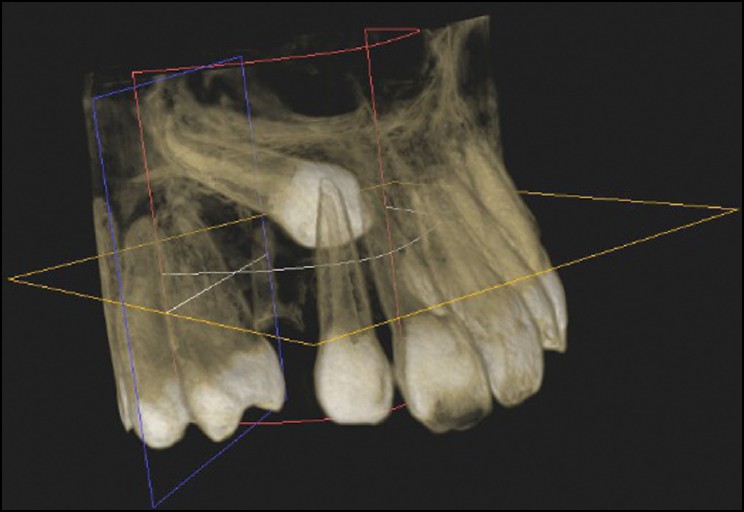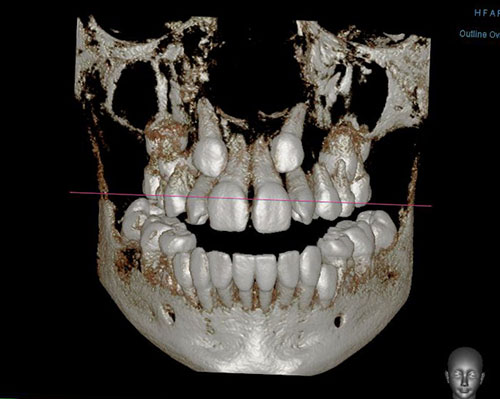
Canine
Exposure
Schedule An Appointment
How Canines Become Impacted
The adult canines are the ‘corner stones’ of your teeth and are extremely important in both function, bite balance, and aesthetics. Perhaps during your last orthodontic appointment, it was noted that one or more of the canines are not erupting into the mouth correctly because of crowding or inadequate space. While your orthodontist uses braces to align your child’s teeth and create adequate space, he or she may request a canine exposure which will make it possible to guide and bring in the canines in their proper position.

Treatment Stages
Your orthodontist may have already placed the braces to align your teeth. During this process, adequate space is created to accommodate eventual eruption of the canines into their proper position.
Dr. Kazemi will expose the impacted canine and place a bracket which has a short chain attached to it. This small chain (gold in color) is ligated to the braces to allow easy access for the orthodontist. If the primary (baby) canine is present, it is extracted at the same time.
Orthodontist can begin the canine eruption in 7-10 days after exposure. Elastic bands are placed on the chain that activates the eruption process. A new elastic band is placed once a month until the canine has emerged through the gum tissue. It is then aligned with the rest of the teeth.
X-ray Needs
A panoramic and small dental (periapical) X-rays are required for canine exposure. The surgeon can localize the tooth and form a plan. Depending on the complexity and position of the canine, a cone beam ct scan may be recommended which provides 3-dimensional position of the impacted canine. CBCT allows the surgeon to expose the canine more accurately and predictably.

Anesthesia
Anxiety is not uncommon among children, especially if they had bad experiences previously. We resolve this in several ways. First, the use of child-specific IV sedation allows them to take a nap during the procedure. This helps to make them comfortable and reduce anxiety. Second, they will be cared by a group of affable staff members who take time to personally connect with each child and allay their fears and concerns. Your child is given full “perceived” control of the events that take place and they approve each step along the way. At no time is a child ever held down, talked to loudly, or strapped. These methods are outdated and ineffective. Finally, the procedure is done in a conservative fashion to help minimize or avoid swelling, pain, and complications that others report as bad experiences.
A person’s dental experience as a child greatly affects their outlook and confidence in dentistry as adults. The best way to manage your child’s anxiety and assure a non-traumatic experience is to have a child-specific IV sedation form of anesthesia. It is the most recommended option and chosen by many parents. However, for very minor procedures in older and more cooperative children, nitrous oxide (laughing gas) and local anesthesia may be adequate. In the very young age group (age 3 to 5) an intramuscular dose of certain medications can also be sufficient. Dr. Kazemi is trained and licensed in administering of office anesthesia. It is very safe and effective. You can rest assured that Dr. Kazemi and his well-trained staff monitor children continually, and make sure that only enough anesthesia is given for the duration of the procedure.
IV sedation is a very safe and predictable in healthy patients when administered by an experienced clinician with proper training and accepted protocol. The patient is continually monitoring during anesthesia and emergency equipment is on hand, if necessary. The medications used have a long history of safety and are short-acting. Anesthesia is also safe In patients with respiratory problems or cardiovascular disease, providing that precautions are taken. To avoid possible airway compromise, patients with severe upper respiratory compromise, such as severe cold with stuffy nose and productive cough are best to postpone the surgery until they feel better.
The facility is equipped with emergency equipment and medications and the entire team is trained to manage any possible complications quickly and properly. The surgeon is CPR and ACLS certified and can manage any complications that arise effectively and quickly. Suburban hospital is in close proximity in the event additional assistance is required.
Recovery
Recovery from canine exposure is relatively easier and faster than most oral surgery procedures. In most, there is no or minimal swelling and pain. Most children return to school and some normal activities within the first day after surgery.
More Information
Fees & Insurance
Information on treatment fees, insurance, and payment options
Frquently Asked Questions
Section on frequently asked questions on canine exposure
Brochure
Download detailed brochure on canine exposure